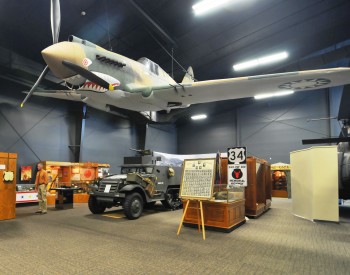
Hanging above the World War II gallery is a full scale replica Curtis P-40B Warhawk fighter plane painted in the markings of an American Volunteer Group “Flying Tiger” aircraft.
By Michael W. Vogt
From Iowa’s frontier, to the major wars of the 20th century, to the Iowa National Guard’s “Warrior Ready” force, the Iowa Gold Star Military Museum exhibits Iowa’s military heritage and the contributions of Iowa veterans and units in a meaningful and entertaining way that appeals to visitors of all ages, from school children to seasoned veterans.
Located at Camp Dodge, in Johnston, the 27,000-square-foot museum was founded in 1985 and contains a collection of more than 100,000 objects, photographs and artifacts. An 18,000-square-foot addition completed in October 2009 tripled the facility’s size. Inside, visitors may explore a variety of exhibits chronicling Iowan’s service to state and nation, on land, at sea and in the air.
Entering the museum visitors are greeted by a photo and artifact exhibit honoring Gold Star Iowans who gave their lives from World War I to the present. A nearby exhibit gallery details Iowa National Guard history from its 1839 founding as the Territorial Militia through its evolution into a “Warrior Ready” force able to deploy in response to state or national emergencies. Another gallery traces the evolution of the Iowa State Patrol from its formation in 1934 to the present.
Entrance into the 12,000-square-foot main gallery begins with Medal of Honor graphic panels including citations and images of Iowa’s 66 recipients from the Civil War through the War on Terror. A small arms galley of more than 300 U.S. and foreign military weapons from the early 19th through the late 20th centuries permits visitors to explore the technological development of firearms from flintlocks to anti-tank rifles and rocket launchers.
Proceeding into the main gallery, the chronological story of Iowa’s military past begins with the “Military Frontier.” The U.S. Army’s role in what would become Iowa began with Lewis and Clark’s 1804 Corps of Discovery journey up the Missouri River and the burial of Sgt. Charles Floyd, the first U.S soldier to die west of the Mississippi River, near present day Sioux City. The exhibit further interprets Dragoon explorations in Iowa, military road construction, the establishment of nine Army frontier forts, and the participation of Iowa troops during the Mexican War of 1846-1848.
A newly constructed Civil War exhibit features a full sized diorama depicting Iowa troops at the April 1862 Battle of Shiloh, Tenn. Display cases contain muskets, artifacts, documents and souvenirs interpreting the role of Iowa volunteers serving with cavalry, infantry and artillery units of the Union Army. An interactive “wheel of fate” utilizing Civil War casualty and service statistics for Iowa volunteers tempts visitors to determine their chances of survival with the push of a button. A nearby surgeon’s kit graphically symbolizes the efforts of Iowa volunteer army physicians to treat the wounds inflicted by musket and cannon fire on Civil War battlefields.
TO READ MORE ABOUT THIS STORY AND OTHER FASCINATING STORIES ABOUT IOWA HISTORY, subscribe to Iowa History Journal. You can also purchase back issues at the store.
